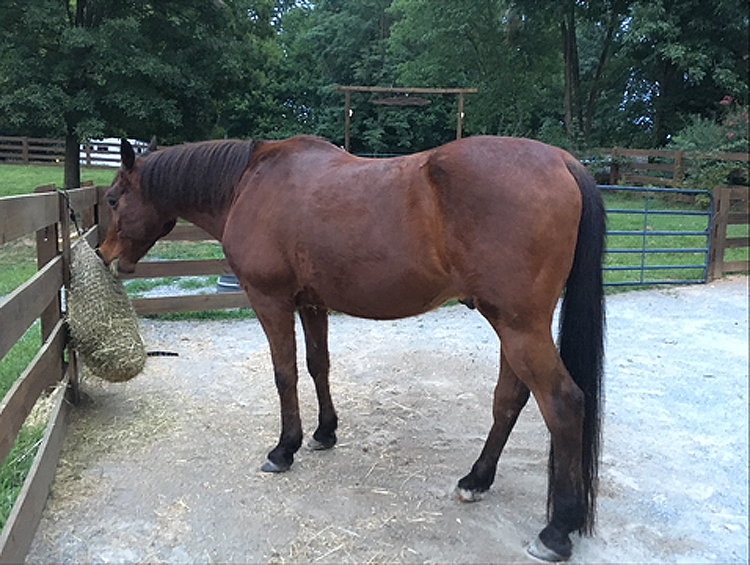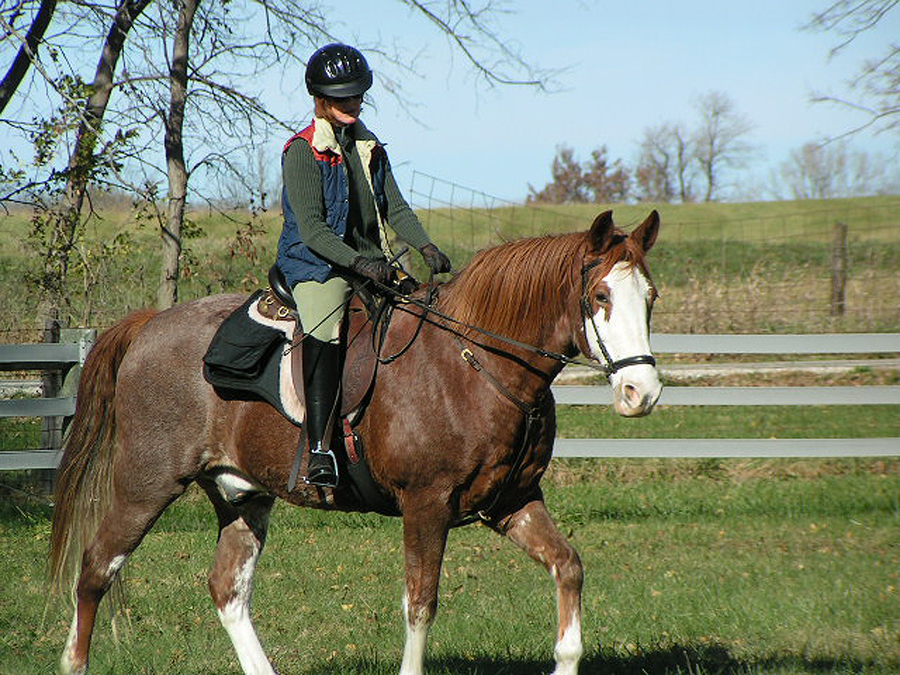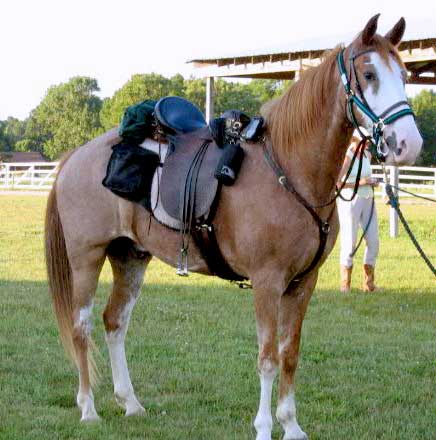FAQ
We've grouped our frequently asked questions into four categories for your convenience.
Pituitary Pars Intermedia Dysfunction (PPID)
What is Cushing's Disease/Pituitary Pars Intermedia Dysfunction (PPID)?
In the horse, what is commonly called Cushing's Disease is caused by hyperplasia (enlargement) or adenoma (benign tumor) in a portion of the pituitary called the pars intermedia (intermediate lobe). Therefore, to be more accurate in describing it, the term PPID — Pituitary Pars Intermedia Dysfunction — is really the correct term. This disorder of the pituitary gland results in hormonal disturbances by secreting high levels of several hormones including ACTH, which stimulates the production of cortisol, a stress hormone. This is generally considered a disease of middle-aged or geriatric equines.
What is ACTH?
ACTH: Adrenocorticotrophic Hormone. A hormone produced by the pituitary gland that triggers production of cortisol from the adrenal gland. Also the name of the single-draw blood test (endogenous ACTH) used to diagnose PPID/Cushing's disease.
What is Cortisol?
Cortisol: A hormone produced by the adrenal gland that is released naturally during times of stress (e.g., excitement, transport, exercise, infections, trauma, pain, fear). When production is abnormally high and sustained, it can result in impaired immune function, resistance to insulin, electrolyte abnormalities, and impaired ability to utilize protein in the diet.
What is Pergolide? What is Prascend?
Pergolide (pergolide mesylate): A dopamine-agonist medication, available by veterinarian prescription and dispensed by a compounding pharmacy; pergolide is considered the gold standard of treatment to control the symptoms of PPID/Cushing's disease.
Derived from a natural class of compounds, pergolide mesylate is the active ingredient in Prascend. As described above, pergolide mesylate is also available in compounded form. See also Treatment of PPID and What is Pergolide?
What is Chaste Tree Berry?
Chaste Tree Berry (Vitex agnus-castus) or CTB: An herb with some of the same effects as the drug pergolide, which may control PPID/Cushing's disease symptoms in some horses but will not control the progression of the disease or growth of the tumor. Most horses will need to be placed on medication for effective control.
What is Vitex?
Vitex: Vitex agnus-castex, the botanical name for Chastetree. (See above.)

What other drugs work for PPID?
An injectable formulation of the drug cabergoline has been effective for horses which do not respond well to pergolide.
What is the Seasonal Rise?
Testing during the seasonal rise increases the chances of diagnosing early cases of PPID. Seasonal Rise may also influence insulin and glucose tests. More information here: SEASONAL RISE
Should I test my horse during the Seasonal Rise?
Testing during Seasonal Rise as a conclusive first diagnosis of PPID won't be accurate unless also accompanied by a constellation of other PPID symptoms. To be considered "full blown" PPID, the horse will test positive all year round. Testing horses experiencing late Summer/Fall laminitis (not diet induced) is recommended, since these horses may benefit from seasonal low doses of pergolide. Testing during the Seasonal Rise can also help owners and veterinarians of confirmed PPID horses adjust medication doses. More information here: SEASONAL RISE
Equine Metabolic Syndrome (EMS)
What is EMS?
Equine Metabolic Syndrome (EMS) is a condition where cells do not respond normally to insulin, the hormone primarily responsible for transporting glucose into the cells. It is sometimes also referred to as Insulin Dysregulation, Insulin Resistance, or the earlier terms Pre-Cushing’s or Cushingoid. These can complicate obtaining a correct diagnosis. While Insulin Resistance (IR) often occurs in the horse with PPID/Cushing’s Disease, EMS is a distinctly separate condition from PPID and it can occur without PPID.
What is the difference between PPID and EMS?
Pituitary Pars Intermedia Dysfunction (PPID) is a disease that is controlled via medication. Equine Metabolic Syndrome (EMS), sometimes called Insulin Dysregulation or Insulin Resistance (IR), is not a disease per se, but a metabolic type that must be managed, most often through diet.
Horses diagnosed as PPID may also be IR. In these cases, PPID must be controlled via medication to not further increase insulin. IR will again be managed by diet.
What drugs might be used for EMS?
The first and indispensable step in controlling EMS is a low sugar/starch diet with balanced minerals. No drug can take the place of a controlled diet, or work well without it. When the horse is sound, exercise is the most potent tool for controlling EMS.
When the horse fails to respond sufficiently to diet, or diet with exercise, especially if laminitic, medication with metformin can be tried, although it often stops working over time. The SGLT2 class of drugs, such as Invokana, are showing promise in horses.
DDT+E
What is DDT + E?
DDT + E is an acronym for Diagnosis, Diet, Trim and Exercise. All must be addressed together for a successful recovery/rehabilitation.
Why is Fasting not recommended before blood work?
The goal of testing is to see how the horse’s insulin responds to what he or she is eating.
Horses that have been fasted (nothing to eat from the time of the previous evening's feeding until after drawing blood the next morning) ill have a lower insulin and ACTH than if they had continued access to hay. “Normal” insulin laboratory ranges usually include fed horses, and are too high for a fasted horse.
Horses that are fed meals will have an exaggerated insulin spike after the meal, particularly the first meal of the day, and therefore will have a higher insulin than if they had free access to hay continually.
For more information see How Fasting Insulin and Lab References Ranges Affect Diagnosis
What is Lab Normal or Laboratory reference range? Why does the lab or the vet say the insulin level is normal, when the EMS calculator shows the horse with EMS?
Laboratory reference ranges are developed from many samples of horses that are assumed to be normal, under all feeding circumstances. The reference ranges, therefore, include everything from a horse that hasn't eaten in 12 hours, to a horse that has just had a big grain meal. The normal insulin for a hay-fed, non-IR horse is much lower than that for a horse that has just had a grain meal. For a horse that has had only low-ESC/starch hay prior to a blood draw, may have an insulin within the reference range, but an insulin above 10 uIU/mL indicates EMS.

How do I interpret Lab results for insulin and glucose?
Go to the EMS Calculator and plug in your lab results. These calculations were developed by a very elegant study by the Virginia Polytechnic Institute, and can accurately assess laminitis risk. See background on the development of proxies and why they are important: Diagnosis of PPID and EMS.
What is the EMS Calculator?
The Equine Metabolic Syndrome (EMS) Calculator is the tool designed to calculate the G:I Ratio, RISQI and MIRG. See EMS Calculator.

What is MIRG?
MIRG measures beta cell responsiveness, or the ability of the pancreas to respond to blood glucose. It is the proxy for AIRg: acute insulin response to glucose. High MIRG = abnormally high insulin response, which is abnormal and likely indicates EMS; but low MIRG is also abnormal and is seen in EMS that has progressed to diabetes.
What is RISQI?
RISQI is a proxy developed by researchers at Virginia Polytechnic Institute. RISQI stands for "reciprocal of the square root of insulin" and is calculated by the equation 1/square root of insulin. A RISQI value of above 0.32 represents normal insulin sensitivity, while a value of less than 0.2 indicates severe Insulin Resistance.
What is the G:I Ratio?
The Glucose to Insulin Ratio (G:I ratio) is a very simple concept. This ratio/number indicates how many "units" of insulin are being secreted per "unit" of glucose. The smaller the number, the less sensitive the cells are to insulin. For example, a normal horse may have a blood sugar of 100 and an insulin of 10, for a GI ratio of 100/10 = 10:1, while an insulin-resistant horse may have an insulin of 25 for that same blood sugar of 100, yielding a G:I ratio of 100/25 = 4:1. Both insulins may be within the laboratory's "normal range", but those normals represent a variety of diets and various times after eating. Obviously, the horse that has a circulating insulin level 250% higher than another horse with the same blood sugar level is less sensitive to insulin. Normal horses fed hay only will have a G:I ratio of at least 8:1.
What is the Emergency Diet?
The temporary Emergency Diet was developed to address the IR horse's immediate needs for adequate gut fill, appropriate energy levels to support requirements, and to improve insulin sensitivity. Meant for initial short-term use only, a mineral balanced, low-sugar/starch diet should be implemented as soon as possible. See DIET — Nutritional Needs for EMS & PPID/Cushing’s Horses
What is the correct hay or feed for my EMS or PPID horse?
Grass hay with combined values for hydrolyzable carbohydrates (HC) — Ethanol Soluble Carbohydrates (ESC) plus starch — below 10% is the goal for most horses.. Any bagged feed should have a combined HC below 10%, with the starch portion below 4%.
What are safe feeds to use as carriers for feeding supplemental minerals, salt, and flax?
Properly rinsed and soaked beet pulp with no molasses added is best. Soybean hulls and Brewer's Dried Grains are also acceptable. If a brand-name feed, it must guarantee HC below 10%, preferably with starch less than 4% and fat below 4%. Just because a manufacturer says it is "safe" or "low" doesn't mean it is. Also check the ingredients list for alfalfa, as some EMS horses are sensitive to it. For a list of US Feeds, see Safe Feeds.
Why is Free-Choice Feeding not recommended?
It has been suggested that horses with EMS must have unlimited access to hay and that even a few minutes without hay is dangerous to them. The rationale is that being deprived of access to food is unnatural and constitutes a stress, causing cortisol release. The cortisol release, in turn, will worsen or perpetuate hyperinsulinemia. A further claim is that this stress and cortisol release will lead to acute, chronic, or recurrent laminitis.
This is dangerous advice that has no basis in fact and attempts to simplify what is not a simple situation. Furthermore, research on cortisol levels in fed versus fasted horses, has shown the exact opposite to be true — fasting lowers cortisol.
The most important consideration with regard to hay, EMS, and laminitis risk is the hydrolyzable carbohydrate content of the hay. Whether fed in limited amounts or free-choice, this is what determines the insulin response and, therefore, how safe (or not) that hay is.
How much should I feed my horse?
ALL horses, regardless of diagnosis, need to be fed 1.5 - 2.0% of body weight.
- 1,000 lb horse x 1.5% = 15 lbs of feed per day
- OR 1,000 lb horse x 2.0% = 20 lbs per day
For horses that need to lose weight, feed 1.5% of the horse's current body weight or 2.0% of the horse's ideal body weight — whichever is more.
NOTE: Starvation diets to address obesity by providing small amounts of poor-quality hay have been universally unsuccessful for the IR horse and will actually worsen insulin resistance.
What are Fructans?
Fructan is a storage form of carbohydrate in plants, made up of very long chains of fructose. Although fructose is a sugar, fructan is not. Mammals do not have the enzymes necessary to break apart the bonds in fructans; fructans are essentially food for the bacteria that live in the gut.
Original work with fructans in the equine was done in a clinical setting via bolus of chicory root inulin administered by stomach tube. While it is true that a really enormous overdose of fructan will cause laminitis, the mechanism for this is hind-gut overload, bacterial die-off, and the subsequent endotoxemia that results. These horses have explosive diarrhea, fever, and are very ill. Laminitis related to pasture or hay fructan levels has never been documented.
Fructans will not cause a rise in insulin. Normal intake of fructan from hay or pasture will not cause laminitis. Simple sugars (ESC) and starch will cause hyperinsulinemia in EMS horses. High insulin is what causes laminitis in these cases.
The vast majority of laminitis is caused by endocrine disorders (PPID and EMS/IR) that raise insulin above normal (hyperinsulinemia).
For more information see DIET — Nutritional Needs for EMS & PPID/Cushing’s Horses and Treatment of EMS.
What are Hydrolyzable Carbohydrates?
Hydrolyzable carbohydrates (HC) are defined as those digestible in the small intestine and the only components that increase blood glucose and, therefore, insulin. For dietary evaluation these are simple sugars (ESC) and starch. See Hydrolyzable Carbohydrates and the Metabolic Horse
What are WSC, NSC, and ESC?
These are laboratory assay terms for various carbohydrate fractions in forage or feeds. Water Soluble Carbohydrates (WSC) are carbohydrates solubilized and extracted in water. Includes monosaccharides, disaccharides and some polysaccharides — mainly fructan. Fructan is a major storage carbohydrate in grasses. Non-Structural Carbohydrate (NSC) is calculated by adding Water Soluble Carbohydrate (WSC) and starch. Ethanol Soluble Carbohydrates (ESC) are simple sugars. Only ESC and starch, the hydrolyzable carbohydrates (HC), will cause glucose spikes and insulin spikes.
What can I do instead of a dry lot?
Equines with uncontrolled insulin should not be allowed pasture access. When dry lot is not possible, use of a muzzle with a sealed opening is recommended. Duct tape and woven baling twine have been used successfully to keep the horse from getting fresh grass.
How important is Exercise?
Exercise vastly improves insulin sensitivity, but the acutely laminitic horse cannot tolerate exercise. However, with recovery, exercise is to be encouraged as long as the horse tolerates it. As the horse's condition improves, the level of exercise should increase. The importance of exercise in the IR-prone horse cannot be understated. EMS can be avoided completely with adequate exercise and diet management. See Exercise For Recovering Metabolic Horses
Laminitis and Founder
What is the difference between Laminitis and Founder?
Laminitis: Weakening of the laminae — the tissues that connect the coffin bone to the hoof wall inside the foot. Often the first sign of PPID/Cushing's or IR is laminitis.
Founder: Often used synonymously with laminitis. Most people use the term founder to indicate a horse whose coffin bone has come loose from its hoof wall attachments and is displaced.
What is the best remedy for Pain?
When an owner is faced with a laminitic horse, their understandable overwhelming concern is pain control. Except within the first few hours of the laminitic and rotation event, pain medications do not help with laminitic pain. For hormonal cases of laminitis, icing also does not help. Identifying and removing the triggering event through diagnosis, diet and medication, if needed, and correcting the trim is critical to provide relief. Diet control, which lowers insulin, can rapidly relieve pain. Pain can be reduced through a corrective trim and the use of conformable surfaces, such as round pea stone, sand, hoof pads, and anti-fatigue mats. The Chinese herb jiaogulan will also support the horse for pain control once all other measures are in place. Also see Laminitis Overview, Realigning Trim. For individual help, please make your case known on the ECIR Group discussion forum.

